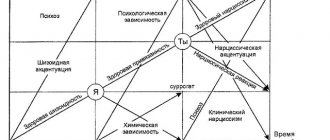Gestalt. “You Just Need to Close Gestalt,” is some advice from well-wishers. But in order to understand what gestalt is and correctly use this concept, you need to take a break from psychotherapy for a while and turn to the psychology of perception.
Literally translated from German, Gestalt means “Form, appearance, Figure,” and its derivative word Gestaltung means “design.” Other Russian analogues that are more or less suitable in meaning are “Integrity”, “structure” and “model”. The official date of birth of the term is considered to be 1890, when the philosopher Christian von Ehrenfels published his key work? ber Gestaltqualit? ten (“On the Qualities of Form.” This scientist supported the point of view of Immanuel Kant - that we cannot perceive the physical world directly. A person always interacts with information received from the senses - modifying it in his consciousness. Thus, any whole for us it is greater than the sum of its parts, because we also invest our perceptions in it.
This idea continued to develop during the 1910s-1930s, when psychologists began to actively study the perception of works of art. Scientists have found that when we look at a picture or statue, the main role is played by a certain holistic perception of the object, which is not reducible to the properties of the sum of its constituent elements. Figuratively speaking, when we look at a painting by Renoir or another impressionist, we do not notice and evaluate every stroke, but we see a single whole and it is this overall combination of colors and shapes that impresses us.
This holistic perception came to be called “Gestalt.” In parallel, the Gestalt approach to perception grew into an independent branch of psychology thanks to Max Wertheimer, a student of von Ehrenfels. In 1912 he published Experimental Studies on the Perception of Motion. The scientist described how two flashes of light, flashing in two different places at different times, can be perceived as one light source moving from one place to another - if the distance and time interval are chosen correctly (the optical illusion worked at an interval of about 60 milliseconds.
Thus, the observer did not perceive two separate elements, but a single whole. This supported the idea that the whole model was different from the simple sum of its parts. Similar experiments were carried out with music - Ernst Mach in his work “Analysis of Sensations” proved that changing the tonality and tempo of a melody does not interfere with the identification of a motive. A similar experiment - but, attention, only with text - is now widely replicated on social networks: thanks to the ability to think in gestalts, you can understand a sentence, even if you change the order of the letters in each word and leave only the initial and final ones in place.
Nparmier, you can easily appreciate this phase.
Gestalt research was continued by the Danish psychologist Edgar Rubin. He divided any image perceived by a person into a figure (object) and a background. The figure is what our attention is focused on, and the background is everything else. To show that figure and ground are mutually exclusive, Rubin created a famous drawing that can be “read” as either a vase or two faces, depending on what you focus on. When faces are the object, the vase becomes the background, but when the vase becomes the figure, the faces immediately and completely recede into the background.
After all, the concept of background and figure persists in everyday life - if we imagine that the reality in which we exist is the background, and various objects or processes are figures. When we have certain needs, we can “Pull out” figures from the background and consciously interact with them, and upon completion of the interaction, the figure merges with the background again. For example, we get hungry and look for food, and after chewing and swallowing a hamburger, we forget about this need and are distracted by something else.
In fact, the “Figure”, the gestalt, can be any process - infatuation with someone, a quarrel or a started business.
We remember unfinished processes better - this phenomenon is called the “Zeigarnik Effect” after the Soviet psychologist Bluma Zeigarnik. While still a student, she noticed that waiters in cafes perfectly remember all unfilled orders and instantly forget completed ones. Later, Zeigarnik conducted a series of experiments that confirmed that unfulfilled tasks create a certain tension in human memory.
This tension helps us not to forget about our needs, but in order for a person to be psychologically healthy, gestalts must be brought to their logical conclusion in a timely manner. An incomplete gestalt can cause an obsessive desire to return to the situation and “Replay” it. And the person begins to repeat previous patterns in changed conditions - for example, he provokes conflicts in new relationships that were unresolved with the previous partner.
The concept has also seeped into pop culture: in the animated series “Transformers,” a gestalt is a complex robot consisting of several smaller robots. The name was invented by fans of the series, but then became official - perhaps because the robot really turned out to be a clear illustration of a complex term.
Close gestalt, what is it. Gestalt of past relationships
If everything in your power is not done and the gestalt is not logically completed, then it will be extremely difficult to move on in life.
Even if we assume that a person managed to build a new relationship under the condition of an open gestalt, he is unlikely to be able to live happily. There will always be a worm sitting inside it and “eating” from the inside. A person will always want to cope with an abandoned task, to say what was not said, to receive what was not given. Only a logical conclusion to the matter will help achieve spiritual harmony.
Closing the gestalt means starting to live again. Leaving the question open means repeating the mistakes of the past over and over again. A woman will subconsciously drag a bunch of old problems into a new relationship and wonder, “Oh my God, why does the same thing always happen to me.”
Don’t you understand why nothing changes in life and in love relationships? Finally, understand yourself, close the gestalt once and for all, move on with your life, it’s simple.
Not HERE and now, but precisely THERE, in past relationships you need to live through disappointment, express anger, express dissatisfaction, take revenge, end things. If they didn’t do this, they brought the problems with them and lived again. And this will happen over and over again, nothing will change either in life or in love relationships until past affairs are completed.
How often do we hear complaints: “In all past relationships, I was cheated on,” “My man didn’t appreciate me. I dropped everything for him, helped, was there, and he...”? Remember, if the same situations are repeated over and over again, in relationships with completely different people, this means that you are doing something wrong. And most likely, you just don’t engage in gestalt. In turn, this situation threatens:
- Psychological disorders – depression, apathy;
- Fears and mistrust towards the new partner;
- Unpreparedness for new relationships;
- Pessimism;
- Failures in all matters and new relationships.
If you can’t cope with all this on your own, then you need to turn to therapy that allows you to forget about your gestalt. Using various techniques, a specialist will help you develop self-awareness, relive situations and correctly forget about them. Typically, specialists use very gentle approaches to patients, and gradually, without traumatizing the psyche, free them from the “shackles of the past.”
Who founded Gestalt therapy?
German psychiatrist and psychoanalyst Fritz Perls went to Frankfurt to become Kurt Goldstein's assistant at the Institute studying brain-damaged soldiers. Goldstein was a researcher of Gestalt theory.
Perls became interested in some Freudian theories and methods and tried to develop his own system of psychotherapy. He came under the influence of many psychologists, psychoanalysts and existential philosophers who directly or indirectly studied the principles of Gestalt and Gestalt therapy.
At an institute for the study of brain-damaged soldiers, he met his wife, Laura Perls, who was also studying Gestalt therapy. The goal of Gestalt therapy was to help patients become aware of basic internal and external sensations in order to better respond to situations.
Therapists help clients focus on the here and now rather than past experiences. Once clients can fully experience the present, it will be easier for them to confront past conflicts or, as Perls called them, incomplete (unclosed) gestalts.
Gesheft – what is it? Translation, use, figurative meaning of the word
Gesheft – what is it? This is the name of construction companies, pawn shops and a festival in Odessa. This is the witcher's sword in the popular game. Where did this word come to us, which has become the slang of young people and a frequently used word among journalists?
Contrary to the opinion about the Jewish roots of the concept of “gesheft”, it appeared far from the Promised Land. There is no such word in Hebrew with a translation that would be correct. This is worth considering. There is no word with a translation that matches the meaning of the word “gesheft”.
This word came into Yiddish, which was spoken by European Jews. It turns out that it has German roots. It came to Rus' together with German traders, who often spoke Yiddish. In Odessa it has an original meaning and means “business”, “profit”. In modern Russia, it has acquired an ironic connotation; words such as “scam,” “kickback,” and “bribe” have become synonymous with it.
What dictionaries say
Kuznetsov’s dictionary defines the origin and meaning of the word as follows:
- Gesheft – from the German “geschaft”, which literally translates as “shop”, means a deal, a profitable deal.
The Dictionary of Foreign Words adds:
- Gesheft is making a profit from a business that requires high ethics and selflessness. This is profit, speculation.
Synonyms are the words: profit, barter, scam.
Use of the word
Gesheft is an integral part of common Odessa expressions:
- What's the deal?
- Small gamble.
- You never mentioned gesheft.
- What a gamble he makes!
- He has a profit from this.
Among young people you can hear that someone is doing musical gesheft - playing a musical instrument at weddings. Everyone has their own gamble: an official turns a blind eye to something and gets a “lamb in a piece of paper”, an apartment broker makes a combination for a fee, even a thief can have a successful gamble. At the beginning of the last century, Odessa words in Yiddish poured into prisons. The guards did not understand them, so there was a rapid spread of Yiddish in thieves' jargon. On it, the word “gesheft” means “profitable business.”
Quotes from the classics
Gesheft is a colorful and capacious word that is also used by writers:
- A.P. Chekhov uses it to describe the atmosphere of dishonest profit in the story “Champagne”: “Where is the drunken revelry, ... the triumph of gesheft...”.
- A. N. Rybakov, depicting the fussy and futile existence of one of the heroes of the novel “Heavy Sand,” notes: “His whole life was a gesheft.”
figurative meaning of the word
The figurative meaning of the word “gesheft” can have a derogatory connotation and is used in the names and definitions of investigative journalism. Thus, “gesheft from genocide” refers to the unscrupulous extraction of benefits, not always monetary, by unscrupulous politicians and businessmen. In this case, the word “gesheft” simply disguises the crime.
It is also used in an ironic sense. There is a well-known joke about a mother and son who walked around the market and bought vegetables. The son was carrying eggs in an armful. After a long bargaining at the tomato counter, the mother, having brought down the price, tells her son to take the anniversary ruble out of his pocket and pay. The son, worn out by the heat, puts his hand in his pocket and the eggs fall. The saleswoman says: “You are forcing me to make a gesheft at a loss” and reduces the price.
Gesheft in Odessa
Having started as a weekend event, the handmade festival in the seaside city has developed and continued. It’s not for nothing that they called it “Gesheft” - these are actually small profitable deals, small investments that quickly and profitably pay off. In the row of souvenirs, the seller wrote an announcement: “I am reducing the price. Bargain." A trip to Gesheft is beneficial for both the seller and the buyer.
An entrepreneur from Odessa founded a club for communication between business people and also called it “Gesheft”. Apparently, the word in the city is accepted as it was many years ago - meaning small-scale production, services, small benefits. Odessa residents say that in fact their Odessa language is real Russian, only earlier.
In fact, the word, which was used in narrow circles of Odessa businessmen, has become slang in our country. Here is another example of how language develops. Borrowing occurred and enriched the speech with a capacious expression. Now this word is in fashion, but in Efremova’s dictionary it is listed as outdated. This is what living speech means!
How can you use gestalts?
In most cases, we try to get rid of gestalts, but they may well be beneficial. Let's look at some of the most illustrative examples:
1. Task lists
. For many people, they add motivation and energy, helping them work more efficiently. If you also keep lists of tasks and are happy to mark those completed, then you are using the power of Gestalt for your benefit.
2. Memory of unfinished business
. We involuntarily use gestalt when we hold something important in memory (for example, a promise to call our parents at 19:00). And we remember this all day, not because we have a good memory, but because we deliberately left the gestalt open.
3. 15 minute rule
. You probably know this rule, which helps you do complex and tedious work. For example, you are faced with a routine task that will take 2 hours to complete. According to the “15 minutes” rule, you need to start right now, but after 15 minutes you can switch to other things. Quite often, gestalt comes into play, helping to complete boring work in one go.
4. Coupons with stickers
. We are talking about booklets in which you need to paste stickers in order to receive some kind of bonus at the end. The secret is that several stickers have already been pasted for you, and this forms a gestalt - the desire to add all the missing stickers, even if the bonus is cheap. You've probably been given such coupons by promoters or hypermarket cashiers.
The above example with stickers looks more harmful than useful, since marketers use the peculiarity of our psyche in their own interests. Hint: to close such a gestalt, just carefully crumple up the coupon and throw it in the trash with a sense of accomplishment.
Still, there are benefits to be gained from this format. For example, you can print out a similar coupon and stickers for it for yourself. Next, while completing certain (not very pleasant) tasks, you can paste in stickers, and when the coupon is full, you can buy yourself a reward.
This approach also works great with children. Does your child want a new smartphone? Print him a small poster with a picture of his goal and space for stickers. After that, give him another sticker for each achievement that you consider important.
Gestalt therapy: concept, history, main tasks
Gestalt therapy today can rightfully be called one of the most effective techniques in modern psychotherapy. It is a humanistic psychotherapeutic direction, which is based on existential (awareness of life and life goals) and experimental-phenomenological approaches.
For the first time, the famous specialist Frederick Solomon Perls spoke about it. This event took place in the early 50s of the last century in the USA. Together with his wife Laura and colleagues, Mr. Perls combined substantially refined pre-existing psychoanalytic theory with several concepts:
- Gestalt psychology;
- phenomenological psychology;
- Zen philosophy;
- existential-humanistic psychology.
It should be noted that Gestalt therapy, although it has absorbed some ideas from Gestalt psychology, is not its applied branch.
Its main task is to help a person develop self-awareness, realize and complete destructive gestalts. The Gestalt therapist does not delve into the patient’s unconscious and does not observe him from the outside, but takes an active part in this process.
The specialist, basing his activities on the main principles of the humanistic approach, treats the client as an equal person. The therapist does not share with the client any bookish and useless advice, but simply helps him find his own right path, using general experience and current resources as a basis. It also helps the patient take responsibility for his life, emotions, reactions, judgments, actions.
To understand what exactly we are talking about, consider the following example. In a wretched hut on the river bank lives an unhappy man who does not even have money to buy food for himself. One day a kind stranger passed by his house, and the poor man decided to ask him for at least some food. The stranger had mercy, caught a fish, fed the poor man and moved on.
The next day the situation repeated itself: a stranger passed by, a poor man asked him for food. But this time the kind man did not directly satisfy the hunger of the poor man. He showed him how to make a fishing rod and how to fish in the river so that he would always have enough to eat.
In the modern world, Gestalt therapy is used in the following areas of life:
- pedagogy;
- conflict management;
- consulting;
- organizational development;
- personal development;
- team building;
- psychotherapy;
- coaching;
- development of creativity, etc.
What is Gestalt?
The concept of “gestalt” comes from the German language and has no direct equivalent in Russian. It means that things are placed or collected together as a whole (whole image). In psychology, gestalt is described as a pattern or configuration. In this context, Gestalt encompasses the human mind and human behavior in general.
Early work on Gestalt theory focused on perception, with particular emphasis on the formation of a visual perception called illusion.
Gestalt theory has played a role in areas of psychology that seek to better understand the brain and explain social behavior. Many of the basic concepts of Gestalt psychology are difficult to define and evaluate experimentally.
Despite criticism of the theory, Gestalt psychology has had a serious influence on psychology in general.
Gestalt prayer. Explanatory text
The text of this prayer is read when someone does not meet your expectations, or you do not meet someone’s expectations, due to your negative childhood experience.
Usually people have expectations (illusions) towards others and, conversely, other people very often want something from you. As a result of unjustified expectations, resentment towards each other always arises.
Any expectations of something from other people are caused by a certain mental mechanism called “fusion”.
This mechanism arises from the fact that each creature distinguishes itself from the mass, while at the same time being part of this mass. A person perceives himself as an individual, while striving to live in a group.
How to make life colorful?
The human psyche is designed in such a way that it is accustomed to dividing the world into “us” and “they”.
Within oneself, a person also experiences a state of merging. At different points in his life, for example, he is first a strict parent and then a helpless child. But at the same time, a person believes that he is a single whole.
When communicating with other people, on the one hand, we separate ourselves from them, but at the same time, we do not allow them to feel and be individual. We expect them to think the same way as we do, to want the same things as we do. We don't even ask other people if they want to be us.
For example, a father wants his adult daughter to return home early, but she does not want this. But they have mutual illusions towards each other. He expects her to come early, and she expects him to leave her alone and allow her to live her personal life.
The text of the Gestalt prayer should be read precisely at such moments when you feel guilty or are trying to blame someone else. In other words, when you yourself are a victim or are trying to turn another person into a victim.
It is better to read the prayer out loud. It’s even better if you pronounce it while looking into the eyes of the one with whom you are merging.
Examples of Gestalt psychology
It is very easy to find examples of Gestalt psychology in our daily lives. In 1912, Wertheimer discovered the “phi phenomenon.” What it is?
Have you ever had a flipbook (picture book) with animated drawings where you turned the pages of a small book with your fingers?
Each drawing is a separate drawing, but when we turn them over in quick succession, we have the illusion that the object is moving. This is an example of a phi phenomenon that has become the basis for movies.
If you draw a circle on a piece of paper, then erase half the circle and look at it again, your mind will still try to see the circle as a whole. This is an example of continuity .
If you've ever looked closely at an oil or acrylic landscape painting, you may have noticed that the painting is made up of various brush strokes that don't seem to make sense on their own. However, if you step away from the painting, you will see brush strokes like grass, trees and hard soil.
This is an example of similarity . We perceive brush strokes as images similar to nature.
When you walk into a restaurant and there is a group of people in the lobby, you can assume that all these people came together because, spatially speaking, people are standing very close to each other. This is an example of intimacy .
Gestalt therapist. Don't wave your arms after a fight
No matter how strange it may sound, all a person’s problems arise from untimely actions. Didn’t finish what he started, didn’t forgive, offended, humiliated - all this becomes a haven of despair, which can accumulate for years, and then pour out in unacceptable forms. It is human nature to avoid problematic situations, put off decisions until later, and “accidentally” forget. But in the meantime, from year to year, many gestalts accumulate in the consciousness. What it is? These are all situations that a person stubbornly ignored or did not attach importance to.
You can often meet people who seem stuck in the past decade. And now we are not talking about aesthetes or freaks who deliberately prefer the fashion of the 20s or 60s. Now the conversation concerns those who still cannot say goodbye to their own past. For something to turn into an expensive vintage, at least 40 years must pass, but clothes that were in fashion 10 or 20 years ago look quite pathetic, funny and irrelevant. This is exactly what people look like who are stuck in the last decade, where they were 25, 30 or 35 years old.
In that distant past, there are a lot of unfinished business and missed opportunities, so people don’t want to leave that place and that time. They are still waiting (though they don’t know what). But as they say, after a fight you don’t wave your fists. We need to deal with the problems of the past as quickly as possible and continue to move forward.
It’s really scary to constantly cling to the past, not admit your mistakes and try to pass yourself off as someone you, in fact, are not. Life passes and does so very quickly. Before you have time to look around, only a few gray days will be left of it. It is reasonable to ask: why then was life given to man? You won’t surprise anyone by stating the fact that a person is capable of anything. But if he is bound by the past, he is helpless.
Learning to live here and now is what Gestalt therapy encourages everyone to do. In life, a person is driven not by his head or mind, but by desires, feelings and needs. Everything a person does, he does for his own good. Such therapy is not developmental psychology, but psychotherapy. Very often at group trainings they talk about simple, one might even say elementary, things in the belief that this is an extremely complex and insoluble problem.
Gestalt therapists are sure that there are no healthy people; we are all a little weird. Therefore, in their approaches they use a simple strategy: “Accept!” And you have to accept it, and if it doesn’t work out, then you can read the prayer written by the founder of the Gestalt method like a spell.
Gestalt is: learning to enjoy the current moment...
Learn to live “here-and-now” and you will be happy, say Gestalt therapists.
Read the article published on our website “The World Bank Report on Russia or the Four Stages of a Long Life” and you will find out what happens to those who neglect the “here-and-now” principle.
In order to learn this principle, there are a lot of Gestalt exercises. For example, learn to chew food thoroughly with your teeth, paying attention to what you eat. You will read more about this Gestalt technique (the favorite technique of Fritz Perls, the founder of Gestalt therapy) in the article “Kitchen secrets of Gestalt therapy”, published on our website.
Projection and introjection in Gestalt therapy
In order for patients to learn to live with their eyes wide open and see life for what it really is (and not neurotic hallucinations), Gestalt therapy teaches them to work with two main problems, which are designated by the terms: projection and introjection.
Having studied the articles “Exercise: “How it really was” and “This insidious projection or “I see all your cards,” you, with the help of simple, interesting and visual psychological exercises and techniques, will come one step closer to the ideal of a healthy person, what psychotherapists understand him - that is, a happy, successful non-neurotic person.
In the article “Victims of Introjection: Who are they?” You will read about how negative parenting prevents us from being rich, loved and happy people. And, of course, in the article you will learn how to work with an undeveloped parent scenario.
In the article “Exercise “The Origins of Our Beliefs,” you will become acquainted with the most specific psychological technique for working through the parental scenario, which is performed in two stages over two days. (This, of course, does not mean that you can stop being neurotic in two days).
Well, if you read the article “The Parable of the Artist or “Don’t forget to give your guests tea,” you will find out why the principle of life “here-and-now” is so important for philosophers and psychotherapists.
Using the example of a bright and paradoxical metaphor, you will learn its deepest philosophical background and understand the correctness of the founders of the Gestalt approach. Or you will understand something else—your own. Which is also great. Because understanding is valuable in itself. And it doesn’t matter what we understand. And now we offer you an amazing gestalt layout for psychological maps , which will help you clear up the problems of the past so that you can move on with peace of mind.
In this article we raised a very rare gestalt topic, and also a very sensitive topic about how visually (from the point of view of his clothes and image) a typical neurotic with open gestalts looks... It is unlikely that you will come across these thoughts (and a particularly satisfactory explanation reasons for this problem) both in the camp of fashion bloggers and in the camp of psychotherapists.
This topic lies “at the intersection” of Gestalt methods, but neither one nor the other deals with it. Meanwhile, there is a problem, it is obvious, omnipresent and can be seen with absolutely the naked eye!
So, the typical appearance of a Gestalt neurotic.
The person appears to be clearly “stuck” in some distinct decade with all its trends and fashions (for example, in the 90s).
For example, he wears long hair in a ponytail (hair), she walks around with a hippie backpack, both have piercings in their ears and black sweatshirts with metal bands, but it still doesn’t look stylish, it’s just sad and scary, like Silent Hill , like dirty, low-quality books at a used bookstore.
Why does a person behave this way? Let's try to figure it out without gestalt psychology.
Does he have no money at all to update his wardrobe? Empty! Things wear out and we buy new ones.
Maybe he lives in complete isolation from information and does not know what people are wearing now? No.
Or is he so angry at the world, at young people, has degraded, and has almost turned into a grumpy old man who believes that “everything was better before” and any modern fashion seems to him in advance disgusting, worthless, insulting him or her personally?
This is already closer to the truth, since from the point of view of Gestalt psychology we all love the era in which our youth occurred, but still no, not quite like that.
There are quite benevolent, kind, cheerful people who have not yet learned to “hate the whole world”, have not yet turned into “old men with a stick blaming the government,” but nevertheless, looking at them, we still state: stuck in the nineties .
At the time when he (she) was 18-25 years old...
As you already know, Gestalt psychologists explain this phenomenon simply. In that fateful decade (of which they are walking advertisements) the maximum number of their unfinished gestalts remained.
If we arm ourselves with Gestalt psychology and its methods, we begin to understand that they do not leave this place and this time, everyone is waiting for something or someone... Everyone is trying to clear up the problems of the past so that they can move on with a calm soul...










